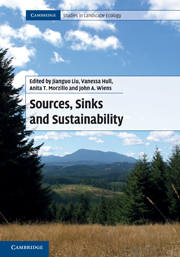Book contents
- Frontmatter
- Contents
- Contributors
- Preface
- Acknowledgments
- Part I Introduction
- Part II Advances in source–sink theory
- Part III Progress in source–sink methodology
- 9 On estimating demographic and dispersal parameters for niche and source–sink models
- 10 Source–sink status of small and large wetland fragments and growth rate of a population network
- 11 Demographic and dispersal data from anthropogenic grasslands: what should we measure?
- 12 Network analysis: a tool for studying the connectivity of source–sink systems
- 13 Sources, sinks, and model accuracy
- 14 Scale-dependence of habitat sources and sinks
- 15 Effects of experimental population removal for the spatial population ecology of the alpine butterfly, Parnassius smintheus
- Part IV Improvement of source–sink management
- Part V Synthesis
- Index
- References
11 - Demographic and dispersal data from anthropogenic grasslands: what should we measure?
Published online by Cambridge University Press: 05 July 2011
- Frontmatter
- Contents
- Contributors
- Preface
- Acknowledgments
- Part I Introduction
- Part II Advances in source–sink theory
- Part III Progress in source–sink methodology
- 9 On estimating demographic and dispersal parameters for niche and source–sink models
- 10 Source–sink status of small and large wetland fragments and growth rate of a population network
- 11 Demographic and dispersal data from anthropogenic grasslands: what should we measure?
- 12 Network analysis: a tool for studying the connectivity of source–sink systems
- 13 Sources, sinks, and model accuracy
- 14 Scale-dependence of habitat sources and sinks
- 15 Effects of experimental population removal for the spatial population ecology of the alpine butterfly, Parnassius smintheus
- Part IV Improvement of source–sink management
- Part V Synthesis
- Index
- References
Summary
Studies of population dynamics of grassland birds have often followed the source–sink paradigm of Pulliam (1988). We present examples of demographic, dispersal, and modeling studies done with bird species found in anthropogenic grasslands of the midwestern USA. Although we believe that we have gained valuable insights into the factors that affect bird populations found in restored grasslands, hayfields and pastures, some of the demographic and dispersal processes assumed in Pulliam (1988) are difficult to measure with grassland birds. More importantly, the population dynamics of many migratory birds do not follow the structure of individual-based models used in the study of source–sink dynamics as pioneered by Pulliam (1988). We suggest measures of population stability such as territory occupancy, age distribution of successful dispersers, production of offspring, and dispersal may be useful as an alternative for assessing the health of grassland breeding bird populations.
- Type
- Chapter
- Information
- Sources, Sinks and Sustainability , pp. 239 - 257Publisher: Cambridge University PressPrint publication year: 2011

